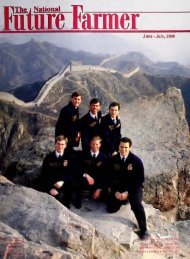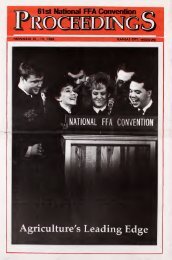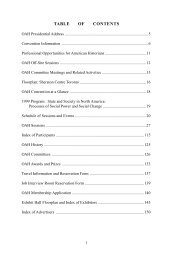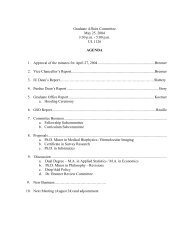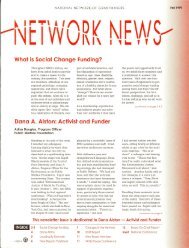National Future Farmer
National Future Farmer
National Future Farmer
Create successful ePaper yourself
Turn your PDF publications into a flip-book with our unique Google optimized e-Paper software.
Satellite images of Earth are helping predict crop yields<br />
and Identify growing problems early. It's . .<br />
.<br />
Advice from Above<br />
EVERY night, in homes across the U.S.,<br />
people watch the local TV weatherman<br />
point to cold fronts and swirling<br />
winds on a wall-sized image of North<br />
America. This picture that helps us<br />
understand the weather has only been<br />
available since the advent of satellites<br />
and their ability to transmit pictures<br />
back to us.<br />
Crop producers, ranchers, commodity<br />
traders and others are now beginning<br />
to harness some of the same space technology<br />
to help them make better, more<br />
accurate decisions. They are using Landsat<br />
satellite images to examine such production<br />
variables as crop vitality, insect<br />
infestations and freeze damage.<br />
Remote Sensing<br />
The Landsat satellites orbit the Earth<br />
at an altitude of 705 kilometers. Their<br />
orbits are synchronized with the sun so<br />
they pass each point on the planet at<br />
about the same time each day.<br />
The pictures, such as the one on the<br />
facing page, are called images because<br />
they're not photographs. TTiey're really a<br />
computer's color-enhanced reproduction<br />
of what the satellite's radio-wave sensors<br />
have recorded while passing over a par-<br />
ticular spot. TTie entire process is referred<br />
to as "remote sensing."<br />
As the satellite repeatedly passes over<br />
a region, recording changes in growth<br />
and other conditions, a producer can<br />
compare the images and decide if there<br />
are problems that need to be addressed.<br />
Down to Earth llses<br />
Oregon farmer Frank Lamb is already<br />
using remote sensing to more accurately<br />
predict potato yields in the Columbia<br />
River Basin. Lamb grows more than<br />
Center-pivot irrigation systems create<br />
the multi-shaded circles in this Landsat<br />
image of the Garden City, Kansas, area.<br />
The unharvested winter wheat crop<br />
appears in gray, both in the irrigated circles<br />
and squares on this composite map.<br />
Plowed ground appears black.<br />
February-March, 1987<br />
2,800 acres of potatoes in the area. With<br />
a high value specialty crop such as potatoes,<br />
advance knowledge of market con-<br />
ditions can lead to sizable profits.<br />
For example, at early harvest time in<br />
1983, potatoes were selling at $80 per<br />
ton. Ninety days later the price had risen<br />
to $ 1 30 per ton because of low yields and<br />
poor quality. Lamb said that such a<br />
market fluctuation means a $750,000 difference<br />
in revenues.<br />
In cooperation with other producers<br />
and a local processor. Lamb has formed<br />
a company, Cropix, to monitor plant<br />
conditions and estimate field acreages in<br />
the valley. Although he has been generally<br />
pleased with the information. Lamb<br />
says the cost is still a bit steep ( 10 images<br />
a year at $665 per image) and the turnaround<br />
time is not as fast as he'd like it to<br />
be. It now takes two weeks for the information<br />
to be processed for Lamb's use.<br />
TTie satellite technology is also being<br />
used in Arizona to catch violators of the<br />
state's water laws. Since Arizona is such<br />
an arid state, some farmers have irrigated<br />
more than their allotment to increase<br />
yields. By purchasing Landsat<br />
images four times a year, Arizona's<br />
Water Resources Department can pinpoint<br />
an illegal field of crops anywhere in<br />
the state. Getting caught means paying<br />
up to $10,000 a day in fines.<br />
Remote sensing is not limited to agricultural<br />
data and irrigation spying. It is<br />
being used widely in geology and monitoring<br />
the effects of urban sprawl on<br />
rural and forested areas. Charting maps<br />
where land surveying is impossible has<br />
been a popular use of the technology.<br />
Like any new technology, it will be a<br />
while before remote sensing will be cost-<br />
effective for most producers. But in the<br />
meantime, you may want to keep an eye<br />
on it—since it's keeping an eye on<br />
you.<br />
•••







